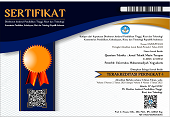Analisa Penentuan Daya dalam Rancang Bangun Controllable Life Saving untuk Keselamatan di KRI
Abstract
KRI is one of the safety equipment to save people who fall in the sea in the form of a lifeboat which is used manually. The purpose of this study is to find out how to design and make a CLS design and determine the amount of power needed for CLS when operating at sea. The research steps were carried out through problem identification, literature studies and surveys. Software design and testing using Maxsurf Modeller Software. The results of the study are: (a) To design a CLS, it should refer to the SOLAS 1978 rules regarding safety equipment, from the results of the analysis of the design and the 1978 SOLAS rules, it is obtained that the CLS Model-1 design with the shape ∩ has a weight of 21 kg, a displacement of 106 kg, capable of carrying heavy 85 kg man, draft 0.2 m, area 3.578 m², thickness 0.006 m, length 1.482 m with High Density Polyethylene (HDPE) material which has a density of 0.93 ton/m³. With the consideration of the factors mentioned above which refer to the 1978 SOLAS rules regarding saving equipment and the results of the analysis of resistance and power calculations, Model-1 is better and superior in operation in various sea conditions; (b) From the results of the analysis of the Model-1 power calculation, a break power of 3,286 kW = 4,406 HP is required to produce a speed of 10 knots.
Keywords
Full Text:
PDFReferences
Ali, I., Augustinus Pusaka, K., Ayom, B., Aldyn Clinton Partahi, O., & Mohammad Danil, A. (2022). Pemodelan Varian Desain Life Buoy Dengan Menggunakan Software Berbasis Energi Terbarukan. Jurnal Sains & Teknologi Fakultas Teknik, 12(1).
Kasenda, G. I. F., Djati, S. P., & Suprapto, S. (2020). Analisis Profesionalisme Prajurit TNI Angkatan Laut Dalam Mendukung Pertahanan Negara di Komando Armada I. Manajemen Pertahanan: Jurnal Pemikiran dan Penelitian Manajemen Pertahanan, 6(2).
Fernando, A., Kusuma, A. C., Suganjar, S., & Astriawati, N. (2022). Optimalisasi Fungsi Alat Keselamatan Di Kapal Mt. Patra Tanker 2. Majalah Ilmiah Gema Maritim, 24(1), 67-75.
Guevara, D., & Dalaklis, D. (2021). Understanding the interrelation between the Safety of Life at Sea Convention and Certain IMO’s Code. TransNav: International Journal on Marine Navigation and Safety of Sea Transportation, 15.
Joseph, A., & Dalaklis, D. (2021). The international convention for the safety of life at sea: highlighting interrelations of measures towards effective risk mitigation. Journal of International Maritime Safety, Environmental Affairs, and Shipping, 5(1), 1-11.
Wulandari, S., Rapi, N. L., & Putra, D. P. (2022). Analisis Kelengkapan Alat Keselamatan pada Kapal Perikanan di Pangkalan Pendaratan Ikan Beba. Lutjanus, 27(2), 71-83.
DOI: https://doi.org/10.18196/jqt.v5i2.21440
Refbacks
- There are currently no refbacks.
Copyright (c) 2024 Quantum Teknika : Jurnal Teknik Mesin Terapan

This work is licensed under a Creative Commons Attribution-NonCommercial 4.0 International License.
Quantum Teknika : Jurnal Teknik Mesin Terapan is indexed by :
Office:
Editorial of Quantum Teknika, Building D, Jl. Brawijaya, Tamantirto, Kasihan, Bantul, Yogyakarta.Telp: (0274) 387656
Fax: (0274) 387646
WA: +62896-7470-8638 (Mirza Yusuf)
Email: jqt@umy.ac.id

Quantum Teknika : Jurnal Teknik Mesin Terapan is licensed under a Creative Commons Attribution-NonCommercial 4.0 International License.















.png)